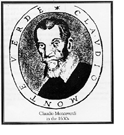|
|
|
| |||||||||||||
|
Study Guide Sampler with Audio Clips Claudio Monteverdi (Italy, 1567-1643)
Altri canti d'Amor: Audio Samples
-
Claudio Monteverdi
These two audio samples from the 1995 - 96 Music Listening Contest compact disc set are available as Shockwave streaming audio files. (Note: The quality of the 16 kbps samples is significantly better and does play well over some 14.4 connections).
Comments by Lynne Warfel-Holt, 16 kbps (for 28.8 modems)
Early in his life, Monteverdi worked as a performer, playing the violin and the viol; during the last 30 years of his life, he worked as maestro da capella (music director) at St. Mark's Cathedral in Venice. Monteverdi believed that music had the power to affect the emotions of the listener. He also believed that music must be subservient to the text. Indeed, Monteverdi's music, such as the example here, is extraordinarily descriptive. In his eighth book of Madrigals, Monteverdi attempted to depict what he called the "three humors (or emotions) of man": stillness, agitation (war), and love. In "Altri canti d'Amor, tenero Arciero," the composer depicts love and war. Notice in particular the difference between the love section (the first four lines of text) and the war section (the last four lines). Monteverdi's career overlapped the end of the Renaissance and the beginning of the Baroque. The madrigal was a Renaissance vocal genre that had been popular throughout the 16th century. It was characterized by an a capella texture and lots of text painting, a term that refers to a composer's ability to describe a word or phrase with music. Monteverdi managed to keep the madrigal contemporary by adding some elements of the new Baroque style. One Baroque element you'll notice in your listening is the alternation of instrumental and vocal sections. The excerpt begins with an instrumental introduction (strings), followed by the vocal line with lute. We refer to this effect of contrasting instrumental or vocal groups as concertato, and it is from this term that the word concerto derives. Another feature of the Baroque was the use of trio texture. This texture is defined by the presence of a bass instrument (a bass viol or a cello), two higher instruments (violins), and an instrument that can play chords and harmonies, such as a harpsichord or a lute. You'll hear the three string instruments and harpsichord at the beginning of the excerpt; the lute enters to accompany the voice for the first line of text.
Altri canti d'Amor, tenero Arciero,History chunks: The Baroque Baroque is a French word that derives from the Portuguese word barroco, which is an irregular shaped pearl. Noel Pluche reportedly first used the word negatively when referring to the fast, pulsating, and surprising music. Jean-Jacques Rousseau called Baroque music "that in which the harmony is confused, .... the intonation difficult, and the movement constrained." By the 19th century the term had become generalized to refer to the historical period between 1600 and 1750, although until the 20th century, music historians preferred terms like "Concertato-style period," or "Figured-bass era." Remember, listen for the vocal texture with instruments, such as strings, harpsichord, or lute. Also, the concertato element the alternation of strings and voice should be easy to hear on a mystery example.
Official Rules and Regulations - Registration Information Background | |||||||||||||||
|
| |||||||||||||||
|
|||||||||||||||
 Claudio Monteverdi Study Guide Text
Claudio Monteverdi Study Guide Text